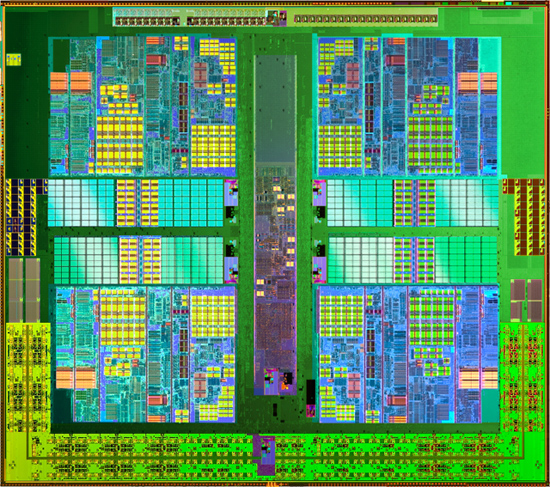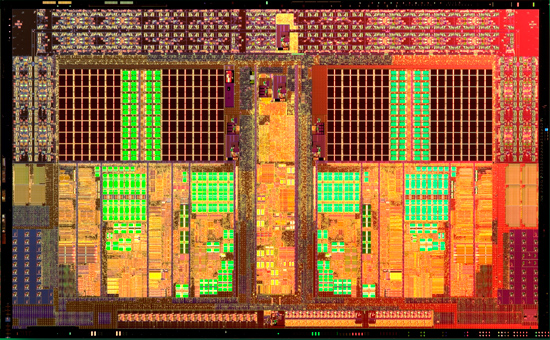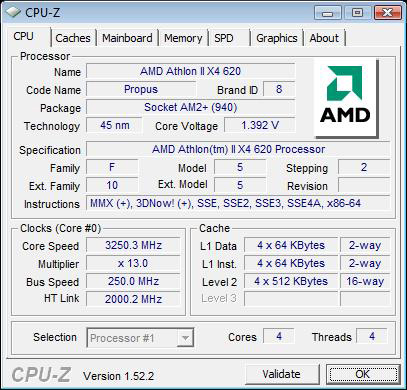AMD Athlon II X4 620 & 630: The First $99 Quad Core CPU
by Anand Lal Shimpi on September 16, 2009 12:00 AM EST- Posted in
- CPUs
How does AMD respond to Lynnfield? Is it by drastically cutting prices on Phenom II? Nope. By introducing the world’s first quad-core processor to debut at $99. Now that’s cool.

It’s called the Athlon II X4 and its existence shouldn’t be any surprise. AMD quietly announced it along with the Athlon II X2 line.

Today we get two models: the Athlon II X4 630 and the Athlon II X4 620, priced at $122 and $99 respectively. The only difference between the two is clock speed; the 630 runs at 2.8GHz while the 620 runs at 2.6GHz. These are both AM3 chips meaning they'll work in AM3 motherboards with DDR3 memory or AM2+ boards with DDR2 memory.
| Processor | Clock Speed | L2 Cache | L3 Cache | TDP | Price |
| AMD Phenom II X4 965 BE | 3.4GHz | 2MB | 6MB | 140W | $245 |
| AMD Phenom II X4 955 BE | 3.2GHz | 2MB | 6MB | 125W | $245 |
| AMD Phenom II X4 945 | 3.0GHz | 2MB | 6MB | 125W | $225 |
| AMD Phenom II X3 720 BE | 2.8GHz | 1.5MB | 6MB | 95W | $145 |
| AMD Phenom II X2 550 BE | 3.1GHz | 1MB | 6MB | 80W | $105 |
| AMD Athlon II X4 630 | 2.8GHz | 2MB | 0MB | 95W | $122 |
| AMD Athlon II X4 620 | 2.6GHz | 2MB | 0MB | 95W | $99 |
| AMD Athlon II X2 250 | 3.0GHz | 2MB | 0MB | 65W | $87 |

This isn’t a harvested Phenom II nor is it a pair of Athlon II X2s, instead it looks like we have a brand new die on our hands (some Athlon II X4s will be crippled Phenom IIs but AMD insists that the new die will be used). The Athlon II X4 has four cores on a single die, but unlike the Athlon II X2 each core only has a 512KB L2 per core. You can tell by the die shot that the core-to-cache ratio is much higher than on the X2:

The 45nm Athlon II X4 Propus die

The 45nm Athlon II X2 die (note the larger L2 per core)
Like the rest of the Athlon II lineup there is no L3 cache. This helps keep the die small (and affordable) but also hurts performance:
| Processor | SYSMark 2007 Overall | E-Learning | Video Creation | Productivity | 3D |
| AMD Phenom II X4 920 (2.8GHz) | 173 | 151 | 212 | 167 | 167 |
| AMD Athlon II X4 630 (2.8GHz) | 157 | 128 | 221 | 131 | 162 |
| % of Phenom II X4 | 91% | 85% | 104% | 78% | 97% |
At the same clock speed the Athlon II X4 should offer roughly 90% of the performance of a Phenom II X4.
| Processor | Cores | Manufacturing Process | L1 Cache | L2 Cache | L3 Cache | Die Size | Transistor Count |
| AMD Phenom II X4 | 4 | 45nm | 128KB per core | 512KB per core | 6MB | 258 mm2 | 758M |
| AMD Athlon II X4 | 4 | 45nm | 128KB per core | 512KB per core | 0MB | 169 mm2 | 300M |
| AMD Athlon II X2 | 2 | 45nm | 128KB per core | 1MB per core | 0MB | 117 mm2 | 234M |
| Intel Core 2 Quad Q8xxx | 4 | 45nm | 64KB per core | 4MB | 0MB | 164 mm2 | 456M |
The price is unbeatable. If we ignore the 630 for a moment, the Athlon II X4 620 is by far the cheapest route to four cores on the market. Intel’s most affordable quad-core is the Core 2 Quad Q8200 at $163, while AMD would previously charge you $163 for a Phenom X4 9600B. This is where the AM3/AM2+ compatibility play really helps out. Motherboard/memory costs are as cheap as possible thanks to AMD's incredible socket flexibility.

And just in case you’re wondering, yes, the Athlon II X4 620 actually delivers performance competitive with the Q8200 but for 60% of the cost. It’s not all that clear cut, there are some cases where the 620 is faster but others where the Q8200 is much faster. On average it ends up being a wash but you’ll want to pay attention to the coming pages to see how the cookie crumbles as it does vary from test to test.

Codename Propus
Overclocking isn't unfortunately as good as the Phenom IIs; the result of a conscious design decision or simply the early nature of the Propus die. That being said, without a single extra millivolt I was able to hit 3.25GHz on my Athlon II X4 620 sample - making it even more valuable. Extra voltage proved mostly useless, I could only approach 3.4GHz with an extra 300mV.
Let’s see, have I thoroughly ruined the surprise? Check. Now let’s get to the tests.
The Test
| Motherboard: | Intel DX58SO (Intel X58) Intel DX48BT2 (Intel X48) Gigabyte GA-MA790FX-UD5P (AMD 790FX) |
| Chipset: | Intel X48 Intel X58 AMD 790FX |
| Chipset Drivers: | Intel 9.1.1.1015 (Intel) AMD Catalyst 8.12 |
| Hard Disk: | Intel X25-M SSD (80GB) |
| Memory: | Qimonda DDR3-1066 4 x 1GB (7-7-7-20) Corsair DDR3-1333 4 x 1GB (7-7-7-20) Patriot Viper DDR3-1333 2 x 2GB (7-7-7-20) |
| Video Card: | eVGA GeForce GTX 280 |
| Video Drivers: | NVIDIA ForceWare 180.43 (Vista64) NVIDIA ForceWare 178.24 (Vista32) |
| Desktop Resolution: | 1920 x 1200 |
| OS: | Windows Vista Ultimate 32-bit (for SYSMark) Windows Vista Ultimate 64-bit |










150 Comments
View All Comments
AznBoi36 - Wednesday, September 16, 2009 - link
Typo on page 2."Any strenuous video encoding however will seriously favor the Athlon II X4. Here we find the $99 620 tying the Core 2 Quad Q8200, and the 620 outperforming it - all at a lower price."
Should be 630.
zivnix - Wednesday, September 16, 2009 - link
We look at the TOTAL system power consumption.We look at the TOTAL system performance.
Why do we compare prices of single components?
If you consider TOTAL system cost, we don't look at 60% price difference. It falls to, what, 10%?
And then even CPUs that cost more make sense.
flipmode - Thursday, September 17, 2009 - link
Does not make any sense in my opinion. I already have a case, a PSU, a DVDRW, several hard drives.... I'm not going to be replacing those for no reason. If you want complete systems compared, go look at system builder prices.mapesdhs - Wednesday, September 16, 2009 - link
Anand, could you include a 3GHz AM2 Athlon64 X2 6000+ into the mix
when doing these reviews please? It would be incredibly useful to
know how the Athlon IIs and Phenoms compare to the dual-core
Athlon64s (no need to compare to anything other than the 6000+). My
older Asrock system is a 6000+ and the mbd can take the Phenom2 X4
3.2GHz - but is it worth it? I don't know. Reviews keeping leaving
out the Athlon64 X2, or if they do then it's some pointless low-end
such as a 5600+.
I expect Asrock will add BIOS support for these Athlon II X4s aswell,
so again some comparison numbers would be good to know.
And given earlier articles here and elsewhere, these new CPUs could
also be a very handy upgrade for those trying to get the most out
of AGP systems.
Ian.
PS. To everyone else: don't respond to the trolls. They merely seek
attention. Replying just fans the flames and is exactly what they
want. They know full well the points made back at them are correct,
but that's not why they're posting. Best thing to do is ignore them.
Natfly - Wednesday, September 16, 2009 - link
http://www.anandtech.com/bench/">http://www.anandtech.com/bench/The scores for the Athlon II X4s are up there.
subbotniki - Wednesday, September 16, 2009 - link
Agree about including the X2 6000+ (great article though Anand).About trolls, AMD and the dragon: Myself is an AMD fan by consumer politital bias. I will always buy and use AMD. Therefore I love to read about a good product they have released. Beeing objective and fair, there are no ways today for an AMD chip to beat the Intel dito.
Hmmm..here everyone knock their heads into the wall - including me: What are we going to compare? Which chip, what cost (incl power eg), plattform etc. Even I hurt my head quite a bit. I've been into hardware for 17 years now (RIP Cyrix!).
The only real straightforward answer I give folk is: what (purpose) are you going to use the chip (computer) to/for? Next question is how big wallet you have and how much you are ready to spend. If money isnt a matter, then we don't need to speculate about whether superman or batman are the best; just buy the most expensive you can get hold of (and if that's not 'nuf - buy some more! In fact it isn't hard to build a system for $200 000. Just a money issue.. ).
I guess most people doesn't have that kind of resources, and the one who has certanly doesn't write comments here. We DO care about prices
and want to have as much as we can have for as little money as possible. Therefore I am convinced that when we messaure chips (consumer stuff) we have to look at the same price. It's not hard to imagine that a $100 000 car is better and fancier then a $10 000. It's also not to hard to understand that most people are going for the $10 000 car.
But if the difference isn't a factor 10 but more like...hmm x 1.2?
Back to basic: how big is your wallet and what are thoose xtra quids leave you with? Purpose again! I KNOW that most people can't tell the difference sitting in front of a 1.7 Ghz Sempron socket A and a core 2 duo 2.2 Ghz. Ever. I'm not talking to you computer freaks, I am talking ordinary stupid user here.
And what I really miss here Anand(You AMD-freak! :-)): Where are the test under Linux enviroment? Take thoose champ for other purposes and you'll come up with some different results..whereas Intel arent fed by MS-platform. Cryptography, MD5 checksum, fileserver etc are test I really miss. I do a lot of video encoding (always in Linux) and would love to see charts from a Linux platform (Yea yea, Phoronix is da shit, but I simply love Anandtech).
I'd better stop now - I know they throw thing @ AMD fans like me..
Peace!
yacoub - Wednesday, September 16, 2009 - link
If they launch one of these at a 45w TDP, it could be great for a small form factor system with a uATX mobo. HTPC...arjunp2085 - Wednesday, September 16, 2009 - link
Hi ,Was searching for Phenom X4 9850 Does not seem to be in the list .. Its not that old In my region where i live that's almost the price range the Phenoms sell for,,,
If possible Please Try adding those charts Does Athlon X4 beat Phenom X4???
blyndy - Wednesday, September 16, 2009 - link
That's a bloody nice deal. So it's only about 70% as powerful as the top of the line processors. It has more than enough processing power for 90% of computer users, and it can handle all the latest games.P.S. "Overclocking suffers a bit as the chips capable of the highest clocks are destined to be Phenom IIs" I can understand that they'll turn a few crippled Phx4s into A2x4s, but why would overclocking suffer on a deneb A2x4 just because some cache has been disabled? Can you please clarify this?
PrinceGaz - Wednesday, September 16, 2009 - link
Doesn't the part "the chips capable of the highest clocks are destined to be Phenom IIs" answer your PS? They test roughly how fast each chip can run, and bin them accordingly. The faster ones end up as Phenom II, the not so fast ones become Athlon II.